
The Complete Guide to Residential Swimming Pool Finishes, Textures, and Tile
Key Takeaways
Selecting the appropriate pool finish influences both aesthetics and maintenance, with options including plaster, aggregate, tile, and pebble.
Tile finishes, available in materials such as ceramic, porcelain, and glass, offer durability, easy maintenance, and a range of design possibilities for luxury pool aesthetics.
Proper installation and regular maintenance are essential for extending the lifespan of pool finishes and ensuring safety, emphasizing the need for professional expertise.
Overview of Pool Finishes
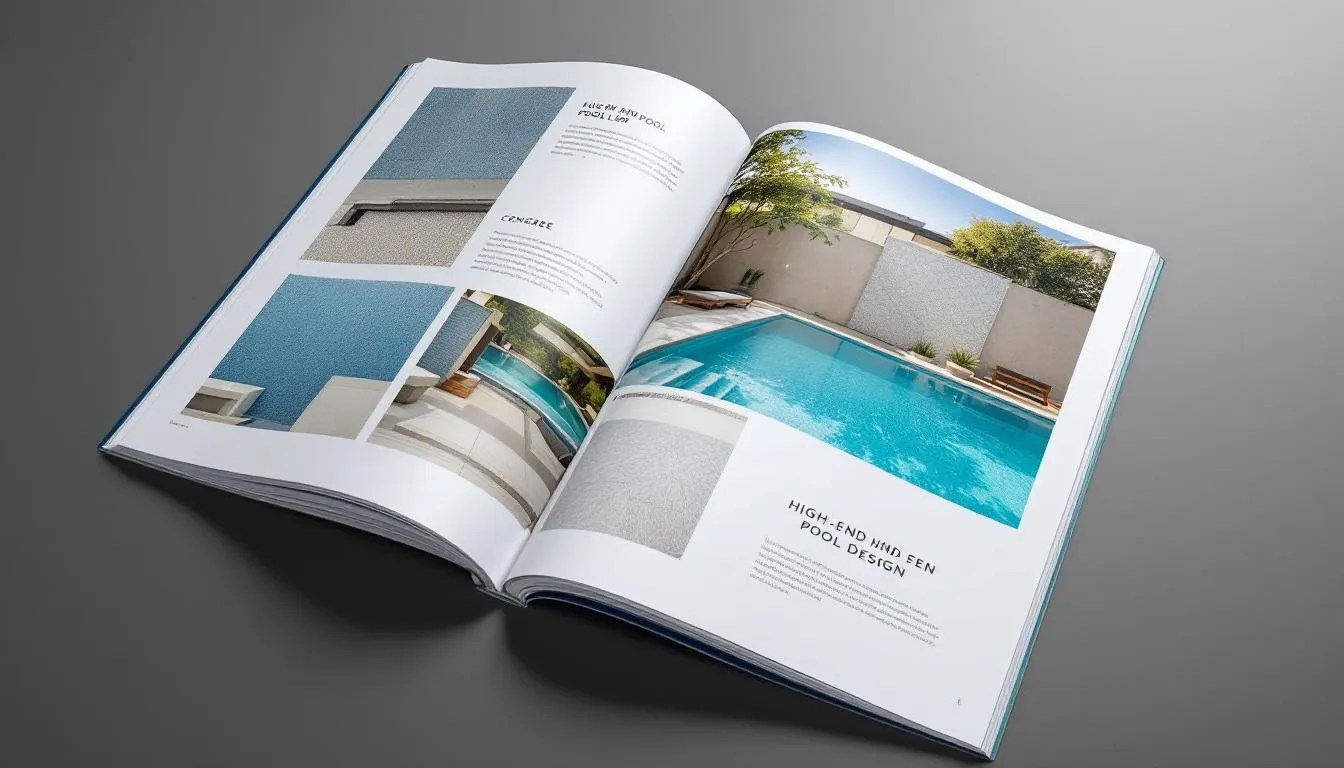
Choosing the right pool finish is crucial in the pool construction process, as it influences both the visual appeal and maintenance needs of the pool. Common pool finishes include:
Plaster: appreciated for its simplicity and affordability
Aggregate
Tile: prized for its luxurious appearance and ease of maintenance
Pebble
Each offers distinct characteristics that can dramatically alter both the look and feel of swimming pools and the swimming pool.
The choice of pool finish can also impact the pool water appearance, with different finishes creating a range of colors from bright blue to lagoon-like hues. Some finishes may require more frequent upkeep, such as plaster, which typically needs resurfacing every 5 to 10 years.
Grasping these details will help you pick a finish that enhances your pool’s aesthetics while fitting your maintenance preferences and budget.
Plaster Pool Finish
Plaster is the most common type of pool surface finish and is often chosen for its cost-effectiveness. Different plaster options include:
Traditional white plaster: Cost-effective and commonly used.
Colored plaster (e.g., medium grey): Enhances the visual appeal by giving the water an enticing blue tint.
Dark plaster colors: Add depth and enhance the reflective quality of the pool’s water.
Despite its affordability, plaster finishes typically last between 5 to 7 years before showing signs of etching or chipping, depending on water chemistry and maintenance practices.
Maintenance for plaster finishes includes regular maintenance, brushing, and chemical balancing to prevent algae growth and staining. Choosing the right pool finish helps prevent leaks and deterioration over time.
Plaster’s ease of application makes it a popular choice for new installations and resurfacing existing pools.
Aggregate Pool Finishes
Aggregate pool finishes are an excellent alternative to traditional plaster, offering:
Enhanced durability and aesthetic appeal
Composition made from a mixture of plaster with small pieces of quartz, granite, river stones, or glass beads
Greater resistance to chemicals and staining compared to traditional plaster finishes
Beautiful colors and textures that can be custom blended to suit individual preferences
There are two main forms of aggregate finishes: polished and exposed. Polished aggregate finishes provide a decorative sheen and timeless beauty, while exposed aggregate finishes feature a rough texture that enhances grip and safety around the pool area. Both types offer unique benefits and can be tailored to create a custom pool interior that reflects your style and enhances the pool’s functionality.
Polished Aggregate Finishes
Polished aggregate finishes are created by applying and then refining a mixture of finely crushed colored stones. This process involves hand-application with a trowel followed by polishing to achieve a smooth, glossy surface. The result is a pool finish that not only looks stunning but also provides a comfortable swimming experience with a smooth surface.
These finishes offer a decorative sheen and timeless beauty, making them a popular choice for pool owners looking to add elegance to their pool’s design. The polished surface reflects light beautifully, enhancing the visual appeal of the pool and creating a luxurious ambiance.
Exposed Aggregate Finishes
Exposed aggregate finishes utilize materials such as tiny river pebbles or glass beads, allowing for customization and a unique aesthetic. These finishes are hand-applied by trained craftsmen and then power washed to expose the aggregate materials, creating a distinctive texture. The rough texture not only enhances the pool’s visual appeal but also provides better grip and safety, especially in high-traffic areas around the pool, including options like a glass bead finish and pebble finishes.
This type of finish is ideal for pool owners who prioritize safety without compromising on style. The variety of materials and colors available allows for endless customization options, enabling you to create a truly unique pool finish that complements your overall pool design and surrounding landscape.
Tile Pool Finishes
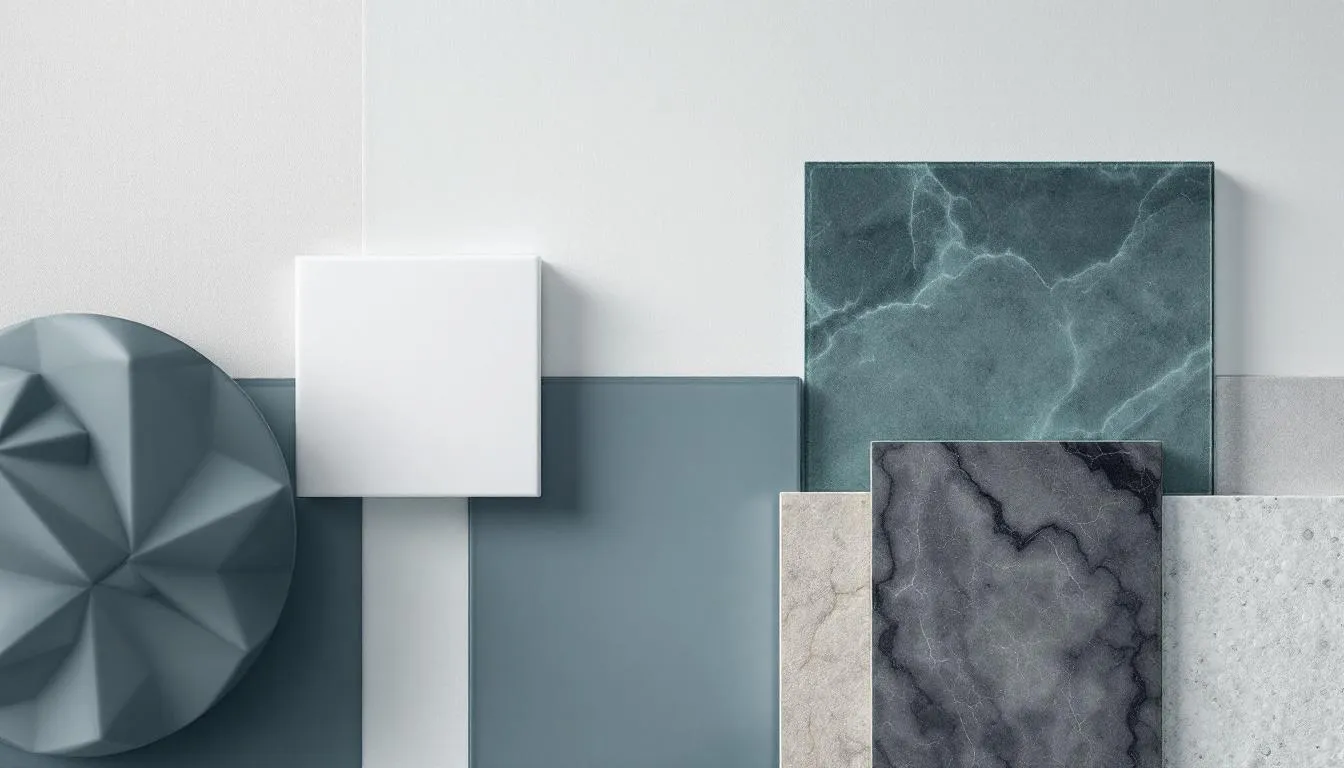
Tile pool finishes are synonymous with luxury and sophistication, offering a wide range of design possibilities and exceptional durability. Common materials for pool tiles include tile materials such as:
Ceramic
Porcelain
Glass
Natural stone
Each material has its unique benefits. These materials are ideal for pool interiors due to their UV and water resistance, ensuring that the tiles maintain their appearance and integrity over time.
Using tile finishes provides durability, artistic looks, upscale glamour, and longevity. Ceramic and porcelain tiles are known for their easy maintenance and resistance to harmful bacteria growth, making tiling a practical choice.
Proper installation ensures pool tiles’ longevity and performance. The cost of pool tiles varies greatly depending on the material type and rarity.
Ceramic Pool Tiles
Ceramic pool tiles are a popular choice for pool finishes due to their budget-friendly nature, durability, and wide variety of colors and patterns. These tiles often feature ornate patterns and mosaics, such as whimsical fish, flowers, Art Deco graphics, and Mediterranean motifs, allowing for creative and personalized pool designs.
Maintaining ceramic pool tiles is straightforward, typically involving simply wiping them with water. The natural clay used in ceramic tiles contributes to their durability and aesthetic quality, making them an excellent choice for pool owners looking to add both beauty and functionality to their pool.
Porcelain Pool Tiles
Porcelain pool tiles have several key features:
Made from a dense material that is highly durable and robust
Non-absorptive and resistant to chemicals, making them ideal for pool applications where longevity and low maintenance are paramount
Offer versatile design options, including the ability to mimic natural stone and wood looks, providing endless possibilities for pool designs
While porcelain pool tiles tend to be more expensive compared to other tile options, their incredibly durable nature and resistance to wear and tear make them a worthwhile investment for any pool owner looking to create a stunning and long-lasting porcelain tile pool finish.
Natural Stone Pool Tiles
Natural stone pool tiles add a touch of luxury and sophistication to any pool, providing a distinctive and authentic look. Popular options include:
Travertine
Slate
Granite Each offers unique textures and colors that can complement a variety of design styles. These tiles are durable and long-lasting, requiring very easy maintenance and withstanding high temperatures. Natural stones are an excellent choice for enhancing the beauty of your pool area.
Travertine tiles, for example, create a calming and inviting atmosphere, while natural stone tiles can enhance both rustic and modern architectural styles, making them a versatile choice for pool finishes.
Glass Tiles
Glass pool tiles are renowned for:
Their vibrant colors and highly reflective surfaces, creating a dazzling visual appeal.
Durability due to their non-porous nature, making them resistant to chemicals, fading, and staining, which requires minimal maintenance.
Offering a wide range of colors, finishes, and styles, allowing for endless design possibilities and unique looks.
However, it’s important to consider the slippery nature of glass tiles when wet and their premium cost due to being made from high-quality materials. Despite these considerations, glass tiles can create a stunning focal point in any pool design, enhancing both functionality and aesthetic appeal.
Textures in Pool Finishes
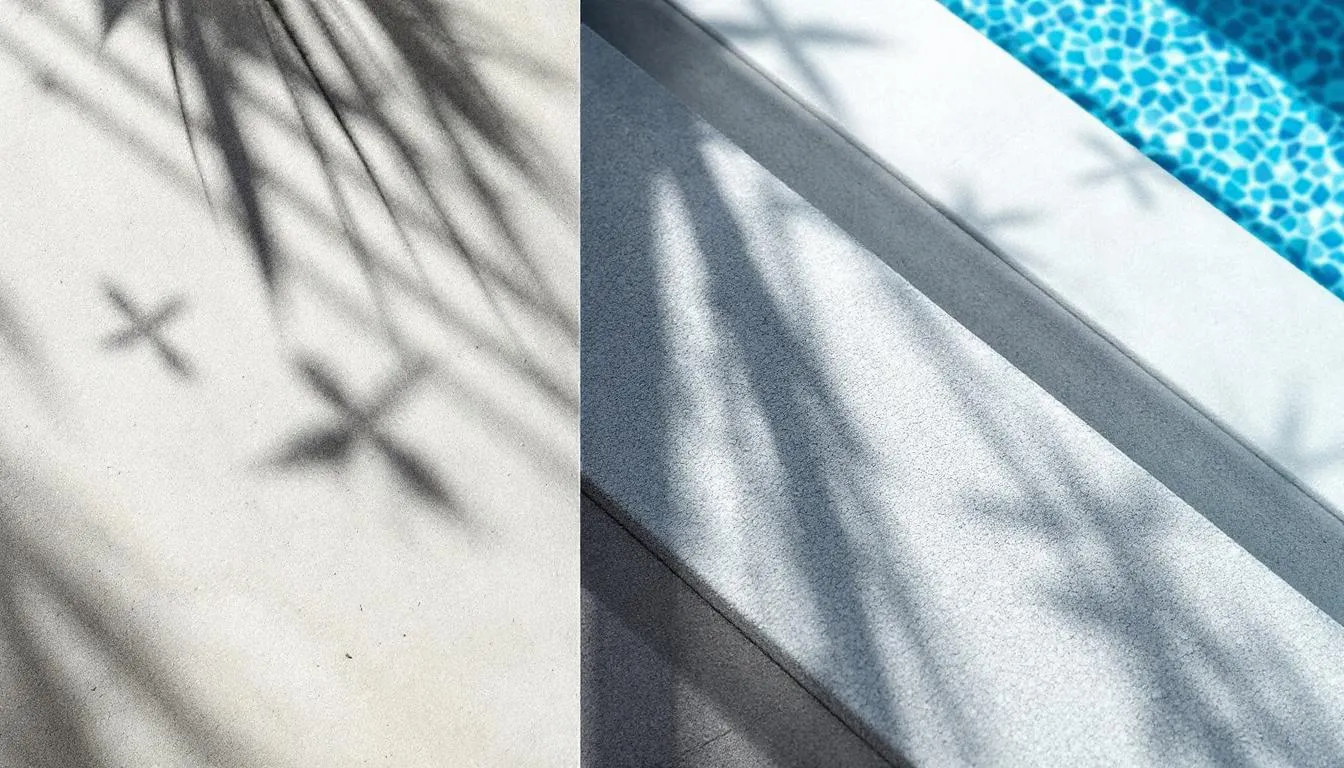
The texture of a pool’s surface is crucial for both comfort and safety, especially in homes with children. Rougher surfaces generally provide better grip, reducing the risk of slips and falls around the pool area. For this reason, tiles with slip-resistant surfaces are highly recommended for pool surrounds.
Natural materials like stone and other materials can offer both aesthetic beauty and practical non-slip benefits when appropriately textured in the surrounding environment. Choosing materials with varying textures can enhance the pool’s aesthetic appeal, creating a visually engaging space while also affecting maintenance needs and providing a textured appearance.
Smooth surfaces, though sleek in appearance, may increase the risk of slipping, particularly when wet, highlighting the importance of slip resistance.
Choosing the Right Pool Finish
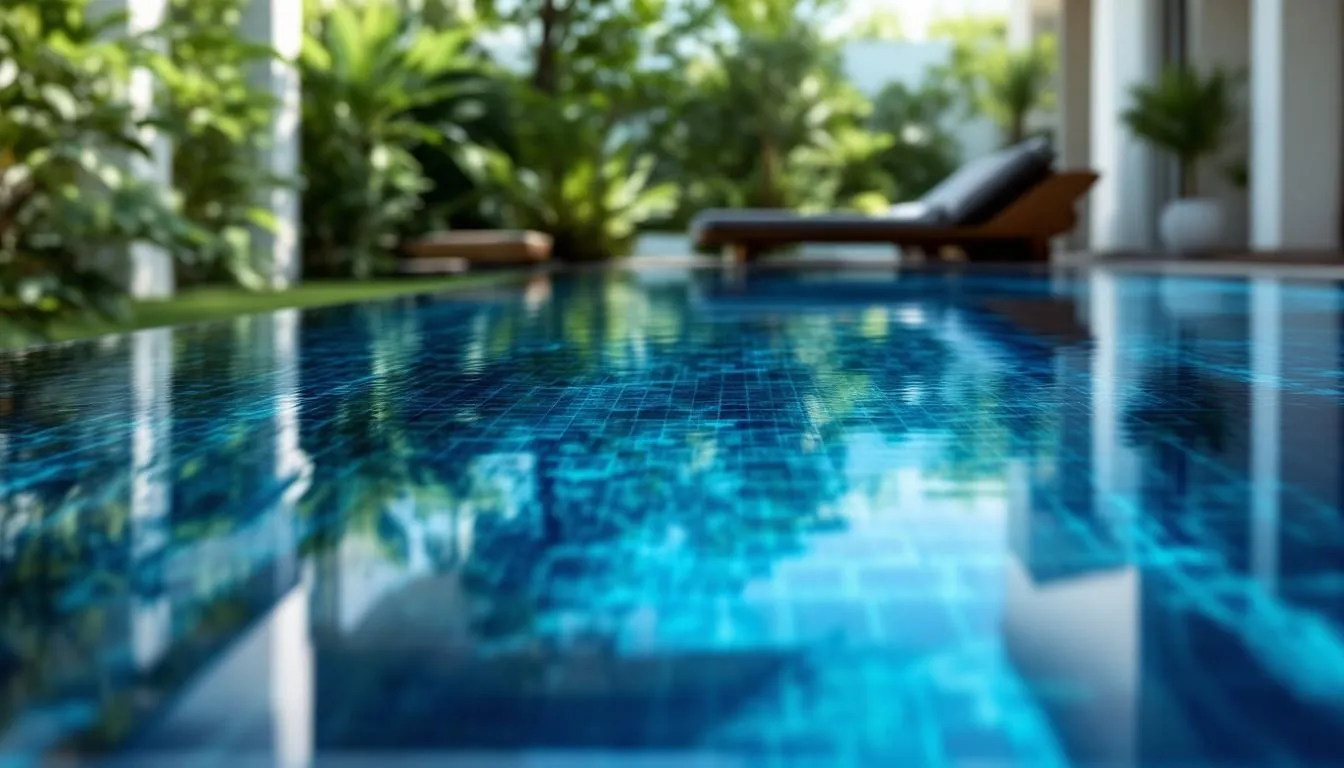
Choosing the right pool finish greatly impacts your pool’s aesthetics and functionality. Consider factors like budget, maintenance needs, and pool usage. For example, plaster finishes are cost-effective but require more frequent maintenance than aggregate or tile finishes.
Consulting with a professional pool builder can provide valuable insights into the best finish options available for your specific needs. A professional can help assess the local climate, pool usage, and personal preferences to recommend a finish that will enhance both the beauty and longevity of your pool.
Installing Pool Finishes
Professional installation ensures:
A high-quality pool finish that enhances durability and aesthetics.
Correct application of pool surfaces by skilled installers.
Avoidance of common mistakes that can lead to costly repairs.
Proper installation techniques create a non-slip surface that adds safety to the pool area. A qualified installer ensures materials adhere to local building codes and safety standards, providing peace of mind and ensuring your pool’s longevity.
Maintaining Your Pool's Finish
Maintaining your pool’s finish requires regular water chemistry tests to prevent damage and ensure a clean, safe swimming environment. Alkalinity levels should be maintained between 80-150 ppm to prevent corrosion, while calcium hardness should be kept between 200-300 ppm to protect the pool surfaces.
Shocking the pool weekly or biweekly helps maintain sanitation and clarity. Algaecides prevent algae growth, and pH-neutral cleaning products avoid damaging the pool finish.
Storing pool chemicals properly prevents hazardous reactions and ensures safety.
Incorporating Tile into Pool Design
Incorporating tile into pool design enhances the visual appeal of the pool and surrounding landscape. Tiles allow for artistic expressions and personalized styles, making the pool area more visually engaging. Mosaic tiles, in particular, create intricate designs that can serve as focal points in pool settings.
Waterline tile serves as a barrier against scum and debris, enhancing the pool’s waterline visual appeal and making maintenance easier. Creative ways to use mosaic tiles include creating shimmering waterline accents or geometric patterns on floors and walls.
Feature walls made with decorative tiles can act as stunning visual backdrops for pools, adding a touch of elegance and sophistication.
Popular Pool Tile Designs
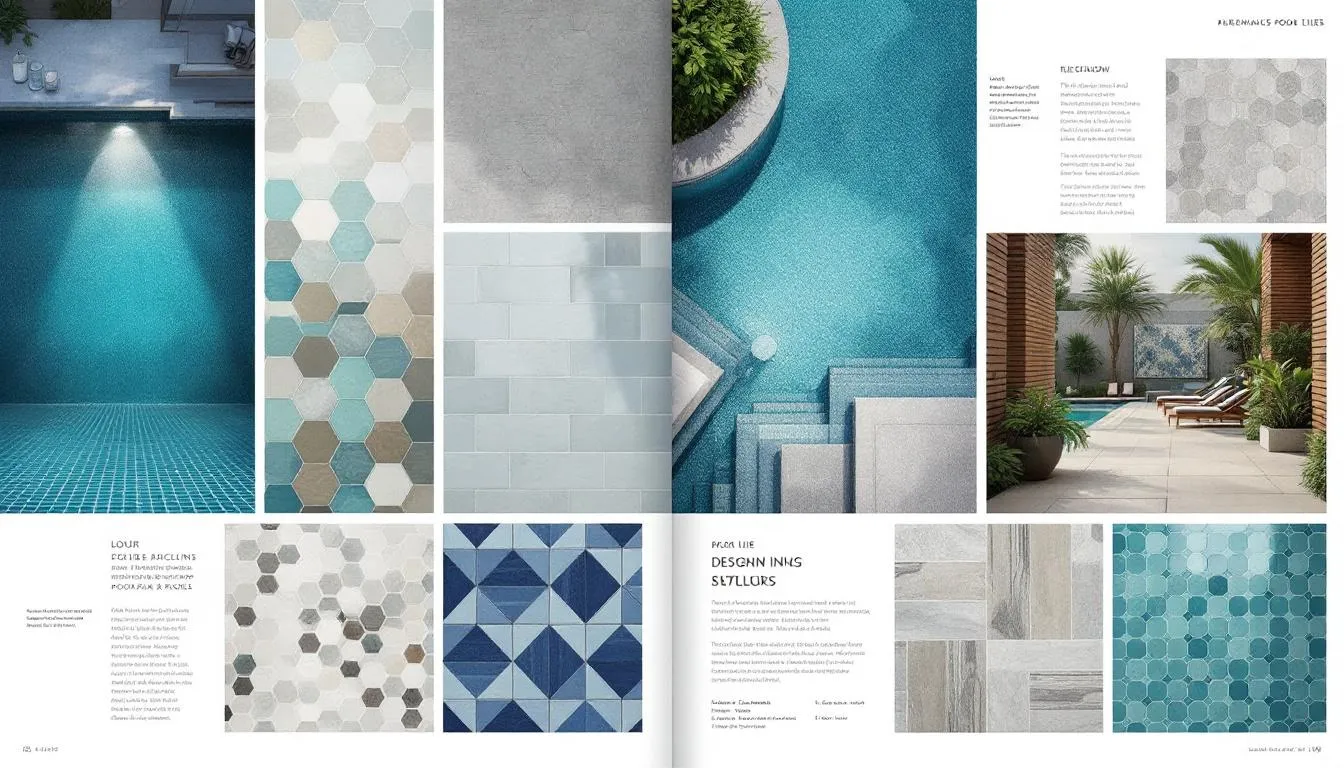
Classic pool tile designs are known for their timeless elegance and enduring appeal, featuring a vast array of traditional motifs and earthy materials. These designs can create a sophisticated and refined atmosphere in any pool area, making them the perfect pool tile choice.
Modern pool tile designs, on the other hand, are characterized by clean lines, geometric patterns, and a stylish tile minimalist aesthetic that aligns well with contemporary tastes, enhancing the pool’s design.
Current trends in pool tiles focus on vibrant tile colors, specialty shapes, and diverse materials. When you choose tiles, tile selection, along with mosaic tiles and contrasting patterns, is particularly popular, adding visual interest and making the pool area more dynamic.
The integration of both classic and modern tile designs, along with current trends, significantly enhances the overall aesthetics of a swimming pool, making it both functional and visually appealing.
Benefits of High-Quality Pool Tiles
Investing in high-quality pool tiles offers several benefits:
Durability and resistance to stains, scratches, and fading
Natural stone tiles are easy to clean and maintain, making them an appealing option for pool finishes
High-quality tiles typically last for 20 years or longer, providing significant long-term cost savings compared to cheaper alternatives
These tiles also contribute to the pool’s aesthetic appeal, creating a luxurious and inviting atmosphere. By choosing high-quality materials, pool owners can enjoy a stunning pool area that requires minimal maintenance and withstands the test of time.
Summary
Choosing the right pool finish is essential for enhancing the aesthetics, functionality, and longevity of your swimming pool. From plaster and aggregate finishes to luxurious tile options, each type offers unique benefits and considerations. High-quality pool tiles, in particular, provide durability, easy maintenance, and long-term cost savings, making them a worthwhile investment for any pool owner.
As you embark on your pool construction or renovation project, consider the various finishes and textures available, consult with professionals, and prioritize high-quality materials. By doing so, you can create a stunning and inviting pool area that will provide enjoyment and relaxation for years to come. Dive into your dream pool and transform your backyard into a personal paradise.
Frequently Asked Questions
What are the most common types of pool finishes?
The most common types of pool finishes are plaster, aggregate, tile, and pebble, each presenting unique attributes for aesthetic and functional appeal. Each option should be considered based on your specific needs and preferences.
How long does a plaster pool finish last?
A plaster pool finish generally lasts between 5 to 7 years, contingent upon water chemistry and maintenance quality. Proper upkeep can extend its lifespan.
What is the difference between polished and exposed aggregate finishes?
Polished aggregate finishes provide a smooth, decorative sheen, while exposed aggregate finishes feature a rough texture for improved grip and safety. Thus, your choice should depend on the desired aesthetic and functionality.
Why are glass tiles considered a premium option for pool finishes?
Glass tiles are a premium option for pool finishes because they offer vibrant colors, exceptional durability, and resistance to chemicals and staining, though they come at a higher cost due to their quality.
How do I maintain my pool's finish?
To maintain your pool's finish, regularly test the water chemistry, use pH-neutral cleaning products, and ensure proper alkalinity and calcium hardness levels. Additionally, employ algaecides to prevent algae growth.



